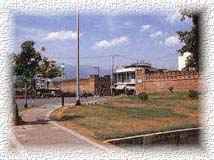|
Lanna, land of a million rice fields, is the name by which the area of ChiangMai and the North have been known for centuries. Bordered by the Mekong River and the mountains of Burma, and walled off by jungles from the central plains, Lanna - and the city of ChiangMai - lived in remote splendour until this century. The early power bases were along the Mekong River. In the mid-13th century, King Mengrai marched south to create an empire in the Kok River Valley, establishing first the city of Chiang Rai, in 1296. After capturing Haripunchai (now Lamphun) and securing joint leadership of Phayao, he sought a more central headquarters and looked for one in the Ping River Valley. Here, Mengrai constructed a fortress and a temple, Chedi Luang. But, as they were unsuitable, he moved further north to establish ChiangMai (New City) in 1296. Because the Ping River frequently overflowed its banks, Mengrai built the royal city of ChiangMai on high ground to the west, surrounding it with a brick and earth wall 1 mile on each side and surrounded by a defensive moat. A smaller wall once embraced a residential section.
Parts of the ChiangMai walls are still intact today, and the area within is called 'the old city' The flowering of Lanna culture dates from the reign of warrior King Tilokaraja. So influential was he that the 8th world Buddhist Council was held in ChiangMai in 1455. Less than a century later, however, the kingdom and ChiangMai were embroiled in many disputes, a situation the Burmese were quick to exploit. After repeated battles, ChiangMai fell to King Bayinnaung of Pegu, in 1558 and was ruled by the Burmese for the next two centuries. While Burma spared ChiangMai, the destruction that it visited upon Ayutthaya in 1767 was devastating. The Burmese conscripted ChiangMai's young men and appropriated supplies for its war against Laos. So severe did the hardships become, that ChiangMai was depopulated. ChiangMai remained empty for 20 years until Prince Kawila ('the hero of ChiangMai') triumphed over the Burmese in 1799 and established his headquarters in the city. For most of the 19th century, ChiangMai was ignored by Burma. When the European colonial power began coveting the region, Bangkok's rulers realised their sovereignty over the area of ChiangMai was in danger. In 1877, a Thai Viceroy took up residence in ChiangMai and, untill 1939, ruled through a ChiangMai Prince. ChiangMai acquired new importance with the dawn of the 20th century. A railway, begun in 1898, was pushed north through thick jungles and mountains, the last rail being laid in 1921. But, while cities to the south began to grow as a result of investment by US government, ChiangMai remained stable. It is only in the last 15 years that Chiang Mai started experiencing rapid growth. So far, ChiangMai has happily managed to avoid beeing changed too greatly by the outside world, and has retained its charm and centuries-old culture. With careful development, the attractions of ChiangMai have been preserved. Today more people that ever enjoy the comfort and charm of Chiang Mai.
Situated between north latitude 17-21 and east longitude 98-99, the province of ChiangMai is found in the upper area of Thailand's northern region. The distance from ChiangMai to Bangkok is 750 kilometres (468.75 miles). ChiangMai valley is 310 meters (1,027 feet) above sea level, and its land covers 20,107 square kilometres. The widest point of the province of ChiangMai measures 136 kilometres (85 miles), and the longest 320 kilometres (200 miles). To the north, a 227 kilometres (141.82 miles) stretch of mountains divides ChiangMai northern districts of Fang and Mae Ai from Burma Chiang Tung (Shan) state. In certain areas, the Kok River also acts as a border between ChiangMai and Burma. On the east, ChiangMai is bordered by the Chiang Rai, Lampang and Lamphun provinces. The Mae Tuen River, ream Mountain and Luang Mountain separate ChiangMai South from the province of Tak. Some portions of ChiangMai South also border the Lamphun province. To the west, ChiangMai is bordered by Mae Hong Son Province.
ChiangMai popularity stems in part from its pleasant climate. Temperatures from mid-November to January average between 13C and 28C (56F and 83F) in ChiangMai; the hills are even colder. Temperatures in ChiangMai begin rising in February and in the hot season (March-May) range between 17C and 36C (63F and 97F). In the rainy season (June-mid November), the highs can drop but the lows not at all. There is no considerable variation between day and night-times temperatures in ChiangMai. The monsoon in ChiangMai begins in May and ends in October, earlier than in Central Thailand. The rain generally falls sporadically - except during August and September when the streets of ChiangMai can sometimes flood.
TAT Government Agencies and Usefull Addresses Tel (66 - 53) ...
Chiang Mai University Huey Kaew Rd. Tel. 221 699 Club Associations in Chiang Mai Chiang Mai Guide Association 334 Nimmanhemin Rd. Tel. 212 942 Golf Clubs in Chiang Mai Chiang Mai-Lamphun Golf Club Sankampaeng Rd. Tel. 248 321-2 Government Agencies in Chiang Mai
Hospitals in Chiang Mai Chiang Mai Ram Hospital 8/4 Boonrueng Rit Rd. Tel. 224851 Chiang Mai Maharaj Hospital Suthep Rd. Tel. 221122 Police Stations in Chiang Mai Chiang Mai Main Police Station Ratchadamnoen Rd. Tel. 221 040 Transport Stations in Chiang Mai Chiang Mai Bus Station 1 Chotana Rd. Tel. 211 584

Content and design © 1997-2001 ChiangMai-Online®, MCC Multitech, Co., Ltd. |


















